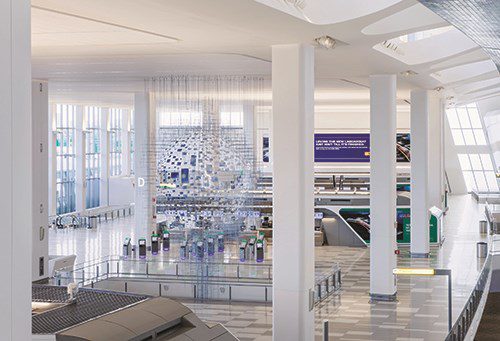Toronto Pearson International Airport (YYZ) and Terminal B at LaGuardia Airport (LGA) clearly know the importance of finding ways to better analyze passenger flow to enhance daily operations. Each independently sought software that could collect and manage data to help improve terminal operations and passenger satisfaction.
After almost two years of dismal passenger volume, many airports are experiencing record-breaking traffic as people finally fly off to their postponed vacations. Business travel is also resuming, albeit not as quickly in most markets. With more travelers taking to the skies, understanding queue times, passenger behavior and terminal throughput are once again critical—perhaps even more so than before due to lingering effects of the COVID pandemic.
As digital technologies continue to permeate the industry, the clock is ticking for airports that are not taking advantage of passenger tracking software.
Toronto Pearson International Airport (YYZ) and Terminal B at LaGuardia Airport (LGA) clearly know the importance of finding ways to better analyze passenger flow to enhance daily operations. Both have complex passenger traffic and need to manage queues to keep operations running smoothly. With a plethora of logistics to take into consideration, each independently sought software that could collect and manage data to help improve terminal operations and passenger satisfaction.
|
facts&figures
Location: LaGuardia Airport, Terminal B Private Terminal Operator: LaGuardia Gateway Partners Consultant & Software Developer: Xovis Equipment: 100 sensors for new 1.3 million-sq.-ft. terminal
Deployment: Sensors installed at taxi stand,
Timeline: Research started before construction began in 2016; system was operational for terminal opening in June 2020 Project: Improving Queue Management & Passenger Flow Location: Toronto Pearson Int’l Airport Operator: Greater Toronto Airports Authority Consultant & Software Developer: Xovis Timeline: Discussion began in 2017; system deployed at check-in area in 2020, expanded to area for international-to-domestic transfers & connections in 2021 Equipment: About 400 sensors for check-in area, about 60 more in area for international-to-domestic transfers & connections Deployment: Airport initially added sensors to cover entire footprint of check-in areas at terminals 1 & 3 (ticketing counters, self-service kiosks, automated bag drops, etc.); sensors later added to international-to-domestic transfer areas Key Benefits: Real-time & historic data about key performance indicators such as wait times, processing times & passenger throughput; enhanced health & safety during pandemic; data can be used to alleviate bottlenecks, improve overall flow & enhance passenger satisfaction |
After researching multiple options, YYZ and Terminal B at LGA both deployed the same software system: Xovis. Designed specifically for airports, it zeros in on queue management, spatial occupancy and wait times.
Fresh Slate in Terminal B
When LaGuardia Gateway Partners began planning the massive redevelopment of Terminal B at LGA, the private operator included provisions for a software system to help improve throughput efficiency by addressing queuing.
“At the time, [we were] also operating the original Terminal B,” explains Edward D’Angelo, director of information technology for LaGuardia Gateway Partners. “During the redevelopment, we launched a pilot program with Xovis in the old facility. Based on its success, we moved forward with implementing the technology in the new terminal.”
When the 850,000-square-foot Terminal B Arrivals and Departures Hall opened in June 2020, it included nearly 100 Xovis sensors in key circulation areas, including outside at the taxi stand and inside near TSA screening checkpoints. The 3D sensors attach to the ceiling and measure passenger flow in real-time, anonymously showing individual guests as colored dots on a computer dashboard. This quickly identifies crowded areas and bottlenecks, calculates and displays wait times, and allows playback of specific time periods for further study at a later date.
“In the security screening area and taxi queue, we use Xovis to measure wait times, which we display prominently for our guests,” says D’Angelo. “We know that security screening can be especially stressful for our travelers, so we are taking the guesswork of wait times out of the equation for ourselves and them.”
The software allows LaGuardia Gateway Partners to establish and monitor key performance indicators that help inform in-the-moment decisions regarding passenger flow. Personnel also study the data retrospectively to improve future operations. Measurements include wait times, processing times and passenger throughput, with information about specific checkpoint lanes measured to the minute. Data that is pertinent to passengers (wait times) is shared on display screens.
“The software allows LGA to receive real-time alerts if a threshold is exceeded,” explains Cody Shulman, head of Airports Product Management for Xovis. “Each airport can set their own thresholds dependent on the data they would like to measure.”
This feature boosts efficiency at LGA by allowing queue zones and other operations to be adjusted at any moment, adds Shulman.
For D’Angelo, it’s all about improving the guest experience. “If our operations team sees queue times building or travelers getting too close together at security screening, we reach out to our partners at the TSA to suggest opening additional screening lanes,” he explains. “Similarly, if we see the taxi queue building, we alert our partners at the Port Authority of New York and New Jersey, who oversee taxi operations at the airport. We also can review historical data to help predict busy time periods and work with our partners to make sure they are prepared.”
Ensuring Privacy
Shulman notes that Xovis designed its software with a privacy-first approach. “The system does not record any video nor imagery and only transmits coordinate data of identified passengers,” he explains. “Each airport or terminal operator owns the data collected on site and is responsible to use it appropriately for operational decisions with security at the forefront.”
At LGA, for instance, the Port Authority only has access to data about taxi stand operations. As the operator of Terminal B, LaGuardia Gateway Partners receives all the data that is collected.
 “The airport owns the data; Xovis doesn’t,” Shulman emphasizes. “Each airport can choose how long they keep the data. They can store data for a month, a year, or over a year and be able to do comparisons and predictions depending on what they decide.”
“The airport owns the data; Xovis doesn’t,” Shulman emphasizes. “Each airport can choose how long they keep the data. They can store data for a month, a year, or over a year and be able to do comparisons and predictions depending on what they decide.”
Privacy features were top-of-mind for officials at YYZ when they were looking for software to help improve operations and passenger flow. The Greater Toronto Airports Authority (GTAA) initially began discussions with Xovis in late 2017, and the new system was activated at YYZ in 2020.
Toronto Pearson Goes Big
The partnership that ensued between Xovis and YYZ resulted in the largest North American installation of passenger flow management technology in a check-in environment. In all, more than 400 sensors were installed at check-in and security areas.
“We are one of the biggest airports to scale and implement Xovis as a solution that captures our entire check-in footprint—every single check-in resource, self-service kiosk and automated bag drop across both Terminals 1 and 3 with over 45 different airlines,” says Faiyaz Patel, manager of Airline Program Development at YYZ. “It was a huge undertaking.”
Patel directly links the project to the airport’s commitment to improving the passenger experience through increased efficiency. “We leveraged what was the best-in-class software available in the market to help optimize check-in at Canada’s largest airport,” he remarks. “The The Greater Toronto Airport Authority (GTAA) has worked closely with Xovis to adapt the technology to help us better understand passenger flow, check-in utilization and throughput along with processing times and physical distancing metrics to support a safe and healthy airport experience during the pandemic.”
 The Ontario airport uses the software to improve the passenger experience by finding efficiencies in the airport journey, Patel explains. Like LGA’s Terminal B, YYZ anonymously measures passenger movements 24 hours a day through ceiling-mounted sensors. The real-time information collected is then used to monitor operational performance and track overall passenger behavior trends throughout the check-in process.
The Ontario airport uses the software to improve the passenger experience by finding efficiencies in the airport journey, Patel explains. Like LGA’s Terminal B, YYZ anonymously measures passenger movements 24 hours a day through ceiling-mounted sensors. The real-time information collected is then used to monitor operational performance and track overall passenger behavior trends throughout the check-in process.
“If we see a specific check-in area where an airline has prolonged wait times or passenger throughput is not where it needs to be, we can use the data to engage in very productive conversations with our airline customers for proactive changes to be made,” says Patel.
“A good example of this is when we began noticing passengers were regularly arriving early to check-in at a specific airline. We saw long lineups build before the check-in even opened or airline staff arrived. It’s this type of information that we’re able to utilize and work with our airline customers to have meaningful dialogue and influence a change in how the operation works.”
The Xovis system has also provided key safeguards for guests and staff during the COVID pandemic. The detailed tracking data not only allowed staff to maintain a bird’s-eye view of the check-in area 24/7 while working remotely elsewhere, it also identified areas where guests were not maintaining enough distance from each other.
Patel notes that having the new system did not change daily operations, but it allowed YYZ to implement extra safety measures while serving guests during a challenging time. The software also identified specific areas within the terminal where corrective action was needed to help guests maintain proper distancing.
“Through this software, we created a scale system that measured the bottleneck areas where passengers were congregating too close together,” he explains. “This physical distance indicator told us when there were hotspots in the terminal, and where we could respond to have our terminal operations team or airlines make appropriate changes. This was extremely helpful during the pandemic.”
Based on the system’s successful use at check-in areas for terminals 1 and 3, YYZ expanded the passenger tracking software into areas for international-to-domestic transfers and connections, which opened in the second half of 2021.

Software Solutions
Understanding and managing passenger flow within terminals has been, and will continue to be, an important goal for airport operators. Better measurement leads to better traffic management, which then leads to a better customer experience. Using software to track travelers anonymously has helped YYZ and Terminal B at LGA gain deeper insights into passenger flow and is fueling efficient operational changes.
 “It was important for LaGuardia Gateway Partners to partner with a technology company to help us use data such as traveler queue times to improve the operational process and guest experience at the new Terminal B,” says D’Angelo. “[We] partnered with Xovis early on during construction to ensure we could capture critical traveler data from Day One of operation in our new Arrivals and Departures Hall.”
“It was important for LaGuardia Gateway Partners to partner with a technology company to help us use data such as traveler queue times to improve the operational process and guest experience at the new Terminal B,” says D’Angelo. “[We] partnered with Xovis early on during construction to ensure we could capture critical traveler data from Day One of operation in our new Arrivals and Departures Hall.”
D’Angelo adds that design and implementation were very successful, and credits Xovis for being an outstanding and collaborative partner.
The scope of deployment at YYZ was even larger, and Patel is similarly pleased: “After the hard work that was put in for the installation, we can confidently say that today it has made a measurable improvement in passenger flow at Toronto Pearson International.”


 Project: Improving Queue Management
Project: Improving Queue Management

